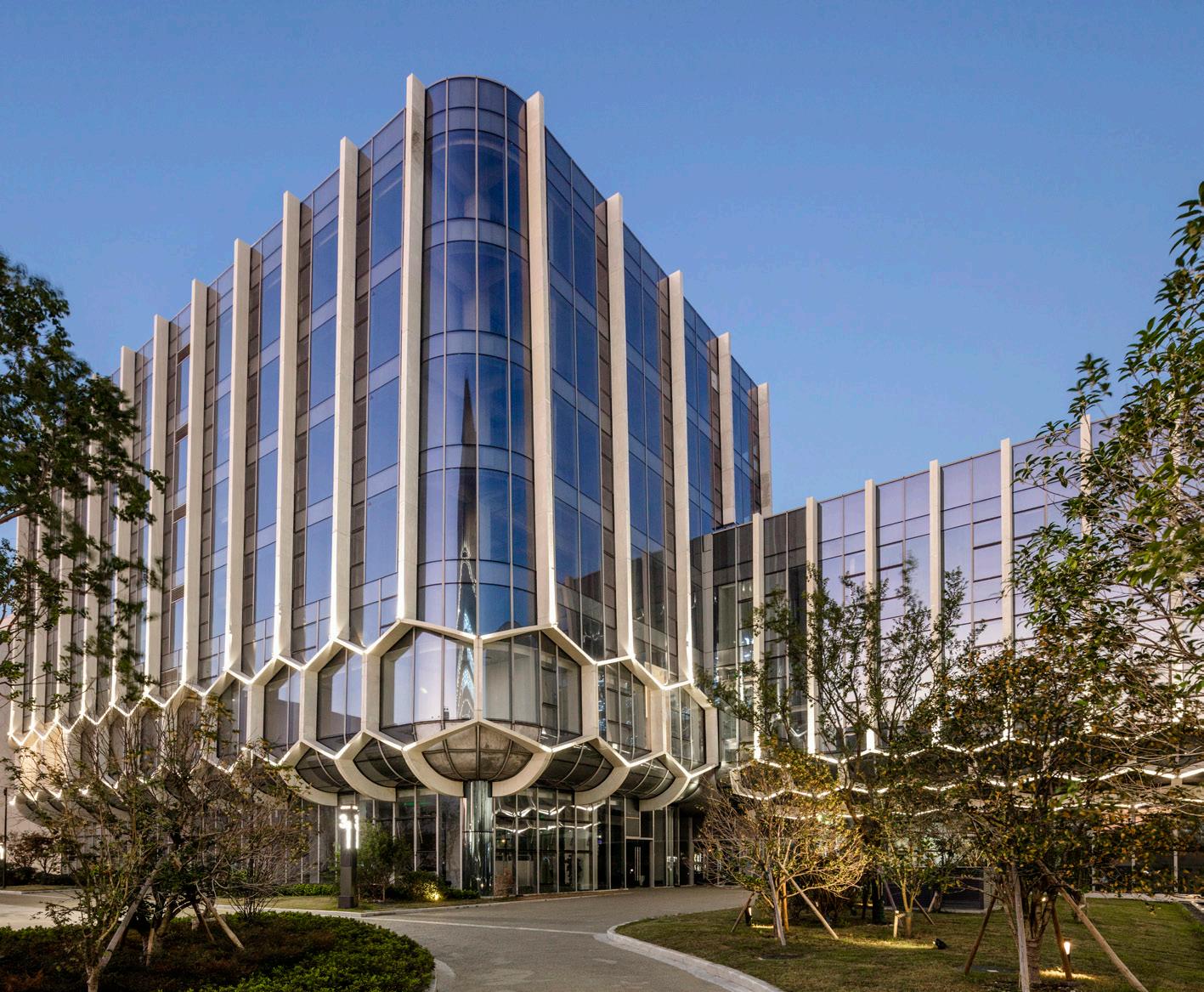
2 minute read
50 Case Study
Benzene Garden
OLI creates a floating campus in Suzhou with an intricate set of facades realized in glass and GFRC.
Design Architect: OLI Architecture
Location: Suzhou, China
Local design institute: AEPA Architects
Engineers
Project management: QNP
General contractor: Nantong Wujian
Construction Engineering
Curtainwall consultant: Talweg Engineering
Studio
Curtainwall consultant for local design institute: Shenzhen OEC Facade Technology
Floating over a reflecting pool in Suzhou, China, the Ascentage Pharmaceutical Headquarters, designed by New York–based OLI Architecture, stretches upward beneath a unique, parametric exterior facade. Created for a young Hong Kong pharmaceutical company, the glass facade references the hexagonal structure of a benzene ring to create a visually interesting and modern way to skin the interrelated buildings on the new 147,000-square-meter research and manufacturing complex.
The design is influenced by an interesting intersection of modern genetic science and traditional Suzhou scholar’s garden. As in these gardens, the focus of the design brings attention to the water, specifically the black Shanxi granite reflecting pool, which makes the gently curved, transparent buildings of the complex feel like they’re floating. This is juxtaposed with a geometric honeycomb-like pattern on the facade, which through its shape highlights the genetic research performed by the company. The pattern is based on the ring that annotates the bonds between disparate carbon and hydrogen molecules. It was designed using adaptive BIM families and stretches upward throughout the building skin.

OLI Architects principal Hiroshi Okamoto told AN that “the clinical and high-tech feel … is purposefully softened by the careful composition of building scale, height, and facade pattern diversity.” Beyond the pattern, the distinctive use of glass on the facade was envisioned to strike an optimal balance of transparency and privacy. Integrated sun shading and careful interior programming of building floor levels and orientations make maximum use of these high-performance insulated glass units (IGUs): The majority of the buildings employ a double-layer curtain wall system, which uses double silver low emissivity (low-e) insulated glass units on the inner side and varying densities of ultra-high strength concrete panels and aluminum extrusions on the outside—these create the hexagonal overlay.
Due to their various material tolerances and strengths, the installation process of the concrete panels was meticulously planned to protect the installed glass. Glass-fiber reinforced concrete (GFRC) support keels and vertical stack joints also offer support. Additionally, several iterations of the design were developed in order to avoid excessive heat stress differentials, yet acute IGU angles still allow for large, prefabricated components with double curvatures to be assembled safely and efficiently.
Okamoto explained that “as energy performance for buildings enclosures have become very demanding in each successive iteration of the Chinese building codes, we needed to use a remarkably high-performing glass with low a solar heat gain coefficient
[SHGC], blocking a good amount of infrared and UV light, while also preserving high VLT,” or percentage of natural daylight.
This contradictory goal is nevertheless challenging a new generation of architects to innovate and adapt to new building codes that stress more sustainable and energy efficient buildings.
In order to customize IGUs to meet both efficiency levels and overarching design goals, OLI worked with Xinyi Glass, a Hong Kong–based glass manufacturer at the cutting edge of low-e glass products. Xinyi provided glass for the entire project utilizing a special low-e coating that achieved the conflicting goals of letting in as much natural light as possible, with as little solar heat gain as feasible. Together, the manufacturer and designers went through several iterations to perfect the coating for both the curved and double-curved glass, so that everything would appear consistent.
The new headquarters is situated within a growing high-tech science and technology center outside of historic Suzhou. The new facilities will allow the company to continue its cutting-edge research in biotechnology and oncology. Charles Gebbia
Above:
Satisfy safety regulations with Aluflam, the key system featuring true extruded aluminum vision doors, windows and glazed walls, fired-rated for up to 120 minutes. Access a wide portfolio of most architectural finishes and indistinguishable products from non-fire-rated doors and windows.













